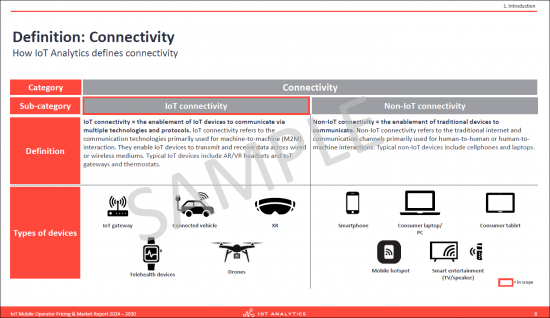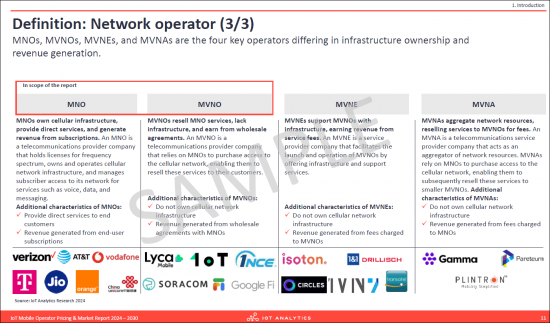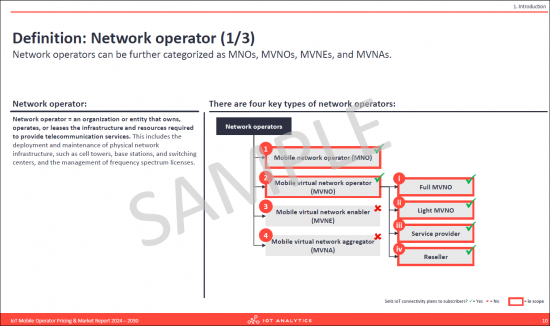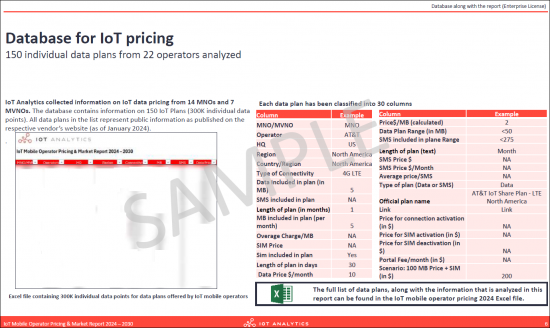|
市場調查報告書
商品編碼
1507976
IoT行動通訊業者的費用及市場 (2024~2030年)IoT Mobile Operator Pricing and Market Report 2024-2030 |
|||||||
本報告是 IoT Analytics 正在進行的 IoT 硬體和連接研究的一部分,涵蓋不同類型的連接、數據計劃,並提供了有關我們主要服務產品的具體見解。我們也對物聯網行動營運商的定價進行基準測試,提供有關按地區和連接類型劃分的物聯網定價動態的寶貴見解。
範例視圖

範例視圖
定義:網路經營者

範例視圖

範例視圖
IoT費用資料庫結構

IoT Analytics 從 14 個 MNO 和 7 個 MVNO 收集有關 IoT 資料費用的資訊。該資料庫包含 150 個 IoT 計劃的資訊。
刊載企業
我們想介紹一下本報告中提到的一些公司。
|
|
目錄
摘要整理
第1章 簡介
第2章 市場規模與展望
- 概要·重要點
- 全球蜂巢式IoT連線數
- 全球蜂巢式IoT連線數:各技術
- 全球蜂巢式IoT連線數:各通訊業者
- 全球蜂巢式IoT連線數:各產業
- 全球蜂巢式IoT連接收益
- 全球蜂巢式IoT連接收益:各技術
- 全球蜂巢式IoT連接收益:各通訊業者
- 全球蜂巢式IoT連接收益:各產業
第3章 競爭情形
- 概要·重要點
- 競爭情形:概要
- 全球蜂巢式IoT連接:市場佔有率
- 全球蜂巢式IoT連接:收益市場佔有率
- AT&T:經營者概要
- Verizon:經營者概要
- Deutsche Telekom:經營者概要
- Vodafone:經營者概要
- Orange:經營者概要
- Telefonica:經營者概要
第4章 與一般的IoT的定價申請相關考察
- 概述/要點
- 物聯網定價和計費的 6 個重要考慮因素
- 供應商定價模型
- 使用者選擇標準
- 結算結構參數
- 一般計費結構
- 每種定價模式的結算結構
- 結算支援和增強功能
第5章 行動通訊業者的IoT費用基準
- 概述/要點
- 研究方法:物聯網費用資料庫
- 定價分析概述:MNO 和 MVNO IoT 連線資料費用
- 具體用戶場景下運營商比較分析
- 蜂窩物聯網連線數據費用:依數據頻段
- 物聯網行動電信業者的收費比較:數據頻段
- 蜂窩物聯網連接數據費用:依技術分類
- 物聯網行動業者的收費比較:依技術分類
- 以資料頻寬劃分的蜂巢 IoT 連線每 MB 的平均價格
- 物聯網行動電信業者的收費比較:數據頻段/MB 劃分
- 蜂窩物聯網連接每 MB 的平均價格:技術分類
- 物聯網行動電信商的收費比較:技術和 MB 劃分
- MNO 蜂巢物聯網連線計畫價格:依數據頻段
- MVNO 蜂巢物聯網連線計畫價格:依數據頻段
- 價格比較:以物聯網行動電信商劃分
- 每 1MB + 1SMS 的 MNO 價格:依資料頻段
- 每 1MB + 1SMS 的 MVNO 價格:依資料頻段
- 物聯網行動電信業者的收費比較:數據頻段
第6章 市場趨勢與課題
- 市場趨勢與課題:概要
- 市場趨勢
- 市場課題
第7章 調查手法·市場定義
第8章關於 IoT Analytics
The "IoT Mobile Operator Pricing & Market Report 2024-2030" is part of IoT Analytics' ongoing coverage of IoT hardware and connectivity. The report looks at the market for mobile operators and provides specific insights into different types of connectivity, data plans, and distinct offerings by Mobile Network Operators (MNOs) and Mobile Virtual Network Operators (MVNOs). Additionally, the report includes an IoT Mobile Operator Pricing benchmark, offering valuable insights into IoT pricing dynamics across different regions and types of connectivity.
SAMPLE VIEW

The main purpose of this document is to help our readers understand the landscape of cellular IoT mobile operators.
Overview of the IoT mobile operator market
The mobile operator market is undergoing a significant shift. Cellular IoT connectivity is experiencing explosive growth, with projections indicating it will account for 3.2% of total mobile operator revenue by 2030.
China Mobile currently dominates the global IoT landscape, boasting a remarkable 46.2% market share in global IoT connections (2023) .IoT Analytics' comprehensive research delves into trends and challenges within the mobile operator market. Notably, the data reveals a significant price disparity: Mobile Network Operators (MNOs) charge 77% more for the 101-500 MB data band compared to Mobile Virtual Network Operators (MVNOs) offering 4G LTE data.
SAMPLE VIEW
Definition: Network operator

A network operator is an organization or entity that owns, operates, or leases the infrastructure and resources required to provide telecommunication services. This includes the deployment and maintenance of physical network infrastructure, such as cell towers, base stations, and switching centers, and the management of frequency spectrum licenses.
Network operators can be further categorized into four types:
- 1. Mobile network operators (MNO)
- 2. Mobile virtual network operator (MVNO)
- 3. Mobile virtual network enabler (MVNE)
- 4. Mobile virtual network aggregator (MVNA)
SAMPLE VIEW

This report details six IoT pricing and billing considerations:
- 1. Vendor pricing models
- 2. User selection criteria
- 3. Parameters for billing structure
- 4. Common billing structure
- 5. Billing structures per pricing model
- 6. Biling support and enhancement
The included mobile operator pricing benchmark covers comparative analyses of operators for specific user scenarios:
- Cellular IoT connectivity data price by data bands in $
- Pricing comparison by IoT mobile operator by data band
- Cellular IoT connectivity data price by technology in $
- Pricing comparison by IoT mobile operator by technology
- Cellular IoT connectivity avg price per MB by data bands in $
- Pricing comparison by IoT mobile operator by data band and MB
- Cellular IoT connectivity avg price per MB by technology in $
- Pricing comparison by IoT mobile operator per technology and MB
- Cellular IoT connectivity plan price by data bands for MNO in $
- Cellular IoT connectivity plan price by data bands for MVNO in $
- Pricing comparison by IoT mobile operator
- Price per 1 MB + per 1 SMS by data bands for MNO in $
- Price per 1 MB + per 1 SMS by data bands for MVNO in $
- Pricing comparison by IoT mobile operator per data band
SAMPLE VIEW
IoT Pricing Database structure

IoT Analytics collected information on IoT data pricing from 14 MNOs and 7 MVNOs. The database contains information on 150 IoT Plans (300K individual data points) . Each data plan has been classified into 30 columns.
Questions answered:
- How large is the market for cellular IoT mobile operators (MNOs and MVNOs) and how is it expected to grow until 2030?
- How many cellular IoT connections are there and how are they distributed amongst various cellular IoT connectivity types?
- What does the competitive landscape of MNOs and MVNOs for IoT look like?
- How do IoT pricing plans for 22 key operators differ by the type of operator and type of cellular IoT connectivity?
- What are the average prices of cellular IoT connectivity for different operators?
- What are the key differences in pricing models and plans offered by MNOs and MVNOs?
- What 15 parameters influence IoT connectivity billing and pricing from an operator perspective?
- What are key emerging trends for MNOs and MVNO?
Companies mentioned
A selection of companies mentioned in the report.
|
|
Table of Contents
Executive summary
1. Introduction
- 1.1. Introduction: Chapter overview and key takeaway
- 1.2. How IoT Analytics defines the "Internet of things"
- 1.3. Definition: Connectivity
- 1.5. Global cellular IoT market forecast
- 1.6. Cellular IoT connectivity value chain
- 1.7. Definition: Network operators
- 1.8. Business model: Network operators
2. Market size & outlook
- 2.1. Market size & outlook: Chapter overview and key takeaway
- 2.2. Global cellular IoT connections 2018-2030 (in Bn)
- 2.3. Global cellular IoT connections by technology 2018-2030 (in B)
- 2.4. Global cellular IoT connections by operator 2018-2030 (in Bn)
- 2.5. Global cellular IoT connections by industry 2018-2030 (in Bn)
- 2.6. Global cellular IoT connectivity revenue 2018-2030 (in $Bn)
- 2.7. Global cellular IoT connectivity revenue by technology 2018-2030 (in $Bn)
- 2.8. Global cellular IoT connectivity revenue by operator 2018-2030 (in $Bn)
- 2.9. Global cellular IoT connectivity revenue by industry 2018-2030 (in $Bn)
3. Competitive landscape
- 3.1. Competitive landscape: Chapter overview and key takeaways
- 3.2. Competitive Landscape - Overview
- 3.3. Global cellular IoT connections - Market share (2022-2023)
- 3.4. Global cellular IoT connectivity - Revenue market share (2022-2023)
- 3.5. AT&T: Operator overview
- 3.6. Verizon: Operator overview
- 3.7. Deutsche Telekom: Operator overview
- 3.8. Vodafone: Operator overview
- 3.9. Orange: Operator Overview
- 3.10. Telefonica: Operator overview
4. General IoT pricing & billing considerations
- 4.1. General IoT pricing & billing considerations: Chapter overview and key takeaways
- 4.2 6 key IoT pricing and billing considerations
- 4.3. Vendor pricing models
- 4.4. User selection criteria
- 4.5. Parameters for billing structure
- 4.6. Common billing structure
- 4.7. Billing structures per pricing model
- 4.8. Billing Support and enhancement
5. Mobile Operator IoT pricing benchmark
- 5.1. Mobile operator IoT pricing benchmark: Chapter overview and key takeaways
- 5.2. Research Methodology - Database for IoT pricing
- 5.3. Overview pricing analysis: IoT connectivity data prices for MNO and MVNO
- 5.4. Comparative analysis of operators for a specific user scenario
- 5.5. Cellular IoT connectivity data price by data bands in $
- 5.6. Pricing comparison by IoT mobile operator by data band
- 5.7. Cellular IoT connectivity data price by technology in $
- 5.8. Pricing comparison by IoT mobile operator by technology
- 5.9. Cellular IoT connectivity avg price per MB by data bands in $
- 5.10. Pricing comparison by IoT mobile operator by data band and MB
- 5.11. Cellular IoT connectivity avg price per MB by technology in $
- 5.12. Pricing comparison by IoT mobile operator per technology and MB
- 5.13. Cellular IoT connectivity plan price by data bands for MNO in $
- 5.14. Cellular IoT connectivity plan price by data bands for MVNO in $
- 5.15. Pricing comparison by IoT mobile operator
- 5.16. Price per 1 MB+ per 1 SMS by data bands for MNO in $
- 5.17. Price per 1 MB+ per 1 SMS by data bands for MVNO in $
- 5.18. Pricing comparison by IoT mobile operator per data band
6. Market trends and challenges
- 6.0. Market trends and challenges: Chapter overview
- 6.1. Market trends
- 6.2. Market challenges











